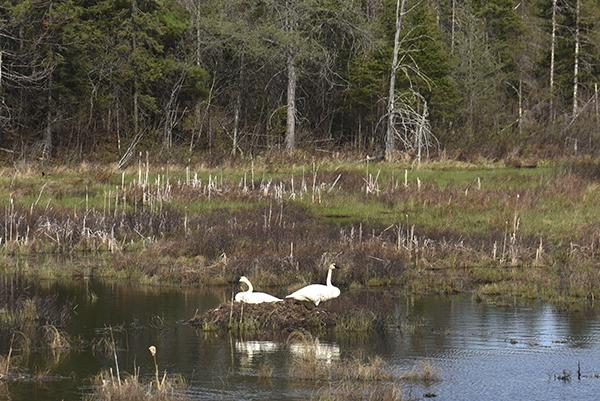By Vicki Browne
Iron County Lakes & Streams Partnership
When a tree dies, it begins the second half of its life.
Michael Bozek makes a case for leaving fallen trees and all their branches intact because they provide valuable habitat for many lake organisms in A Second Life for Trees in Lakes, a publication by the University of Wisconsin Stevens Point.
“When [shoreline] trees die, many fall into lakes creating fish habitat, leaving seedlings in their wake, to mature and replace dying trees, thus continuing the cycle that links these shoreline areas to lakes and streams,” Bozek writes.
Branches and sections of the trunk that are above the water become perches for birds and waterfowl. Turtles and frogs can sunbathe above, while fish and other water organisms are sheltered in the branches below.
Instead of cutting down shoreline trees and hauling fallen ones out of lakes and streams, consider the benefits of letting nature take its course.
• Providing food and cover for a variety of animals while the tree is upright and then in the water.
• Adding tensile strength and preventing erosion as its roots bind soil and stones.
• Dissipating wave energy after its trunk and branches have fallen into the water.
Having downed trees (and woody debris) in the water along the shoreline is necessary for lake health. Counting downed trees is one of the parameters on the Cooperative Lakes Monitoring Program’s Score the Shore procedure. For every 1,000 feet of shoreline, top scores are given when there are 16 or more downed trees along that section. This equates to a downed tree about every 50 feet.
Participating in a Score the Shore event can be a humbling experience. Many of the things we think we know about how a shoreline should look can actually work against having a healthy, vibrant lake.
High scores are given for having floating, emergent (tops above the water) and submerged native plants across 75% of the lake area near the shore. Bulrushes, cattails, duckweed, chara and various pondweeds serve vital purposes. Some mitigate wave action, some hold sediment in place, and some provide food and shelter. All aquatic plants supply oxygen to the lake, uptake excess nutrients, and when they are thriving, lessen algal blooms.
The Michigan Department of Environment, Great Lakes and Energy suggests using docks and swim platforms to reach open water rather than removing vital native aquatic plants at the shoreline.
On the land nearest the shore, points are taken away for having manicured lawns or sandy beaches. Points are added for stretches of native plants, grasses, sedges and shrubs. The longer and wider the stretch of these natives, the higher the score.
Native plants have deeper roots that hold soil in place. Birds, amphibians, reptiles and insects rely on these plants for food, shelter and safety. Dragonflies gather around native shoreline vegetation when they are looking for mosquitoes to eat. On the other hand, geese like the clear sightlines provided by lawns that stretch all the way to the lake.
In its publication The Water’s Edge, EGLE also mentions near-shore lake bottoms. Gravel bottoms allow walleye to spawn and frogs to lay eggs. Mucky bottoms are perfect for insect larvae and invertebrates, which provide food for small fish. Rocky bottoms attract crayfish and smallmouth bass. The only bottom that doesn’t serve the lake well is a sandy one.
“Most species of fish and wildlife don’t thrive along sandy beaches or mowed lawns,” the brochure reads.
According to Jim Dexter, the recently retired chief of the Department of Natural Resources Fisheries Division, “Protecting and restoring shoreline habitat is critical to the health of an entire lake. If you want great fishing, you must protect your natural shorelines.”
As winter approaches and folks begin dreaming about projects for next spring and summer, consider natural shoreline restoration. If the shoreline looks too tidy, the frogs and turtles have moved away, or the waves are causing erosion, it might be time to rediscover the shoreline’s ‘wild’ side.
The Wisconsin DNR offers two good recommendations for erosion control projects that can also pertain to other shoreline work.
• Understand the problem. “Without understanding the problem any actions may be a waste of time and money, and may worsen the problem.”
• Consult a resource professional who has experience with a variety of approaches. “Each problem is unique and there are no generic plans which are guaranteed to work.”
EGLE reminds anyone doing shoreline work that most projects require a permit. The agency also recommends meeting with the Water Resources Division prior to submitting a permit application, so as to minimize costs and potential delays.
To see actual shoreline protection projects, visit EGLE’s Shoreline Protection page on michigan.gov. Learn more about the Cooperative Lakes Monitoring Program at micorps.net/lake-monitoring.
The case for letting fallen trees lie
Image
Body


